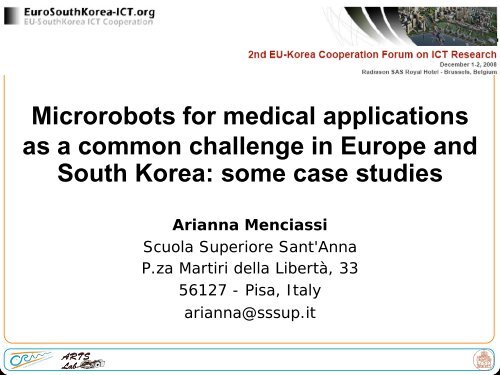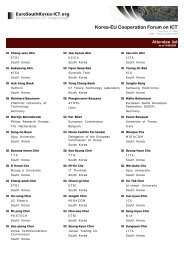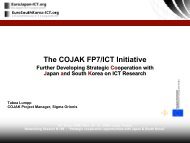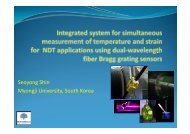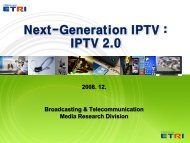Arianna Menciassi - EuroSouthKorea-ICT.org
Arianna Menciassi - EuroSouthKorea-ICT.org
Arianna Menciassi - EuroSouthKorea-ICT.org
Create successful ePaper yourself
Turn your PDF publications into a flip-book with our unique Google optimized e-Paper software.
Microrobots for medical applications<br />
as a common challenge in Europe and<br />
South Korea: some case studies<br />
<strong>Arianna</strong> <strong>Menciassi</strong><br />
Scuola Superiore Sant'Anna<br />
P.za Martiri della Libertà, 33<br />
56127 - Pisa, Italy<br />
arianna@sssup.it
Outline of presentation<br />
Scuola Superiore Sant’Anna: main R&D activities of<br />
the Biorobotics Labs (ARTS and CRIM Labs)<br />
Existing and potential cooperation topics/projects<br />
between SSSA and South Korean institutions<br />
- micro-robotics for endoscopy<br />
- microsystem technologies for neural interfaces<br />
- service robotics and robots for urban hygiene<br />
The existing framework: the Italy-Korea joint Lab of<br />
Biorobotics for improving quality of life.
Outline of presentation<br />
Scuola Superiore Sant’Anna: main R&D activities of<br />
the Biorobotics Labs (ARTS and CRIM Labs)<br />
Existing and potential cooperation topics/projects<br />
between SSSA and South Korean institutions<br />
- micro-robotics for endoscopy<br />
- microsystem technologies for neural interfaces<br />
- service robotics and robots for urban hygiene<br />
The existing framework: the Italy-Korea joint Lab of<br />
Biorobotics for improving quality of life.
82 Faculty<br />
Sant’Anna School… a few numbers<br />
www.sssup.it<br />
• More than 330 PhD/Doctorate/Master students<br />
223 Undergraduate students<br />
More than 724 participants to post-graduate courses and<br />
continuous education programmes<br />
. 900 research assistants, post-docs and research associates
The ARTS and CRIM Labs story: pursuing frontier research, big<br />
challenges and new opportunities<br />
BioRobotics at all scales
ARTS (Advanced Robotics Technology and<br />
Systems) Lab<br />
Coordinator: Paolo Dario<br />
ARTS (Advanced Robotics Technology and Systems) Lab<br />
Coordinator: Paolo Dario<br />
Artificial hands<br />
Hand prostheses<br />
Tactile sensors<br />
Neuro-robotics and<br />
bionics<br />
Neural interfaces<br />
Natural interfaces<br />
Sensory information<br />
processing<br />
Robotics for neurorehabilitation<br />
Assistive robotics<br />
Gerontechnologies<br />
Humanoid robotics<br />
Neurodevelopmental<br />
engineering<br />
Service robotics<br />
Biomimetic robotics<br />
Roboethics
CRIM (Center for Research in Microengineering)<br />
Coordinator: Paolo Dario<br />
TRADITIONAL<br />
SURGERY<br />
MINIMALLY<br />
INVASIVE<br />
SURGERY<br />
Da Vinci CAS system<br />
Force-feedback<br />
scissor for fetal<br />
surgery<br />
ENDOLUMINAL<br />
SURGERY<br />
Endoscopic<br />
capsule<br />
Reconfigurable<br />
surgical system<br />
FETAL<br />
SURGERY<br />
Micro-<br />
endoscope<br />
for spinal<br />
cord<br />
CELL<br />
SURGERY<br />
Artificial virus<br />
for cell therapy
Outline of presentation<br />
Scuola Superiore Sant’Anna: main R&D activities of<br />
the Biorobotics Labs (ARTS and CRIM Labs)<br />
Existing and potential cooperation topics/projects<br />
between SSSA and South Korean institutions<br />
- micro-robotics for endoscopy<br />
- microsystem technologies for neural interfaces<br />
- service robotics and robots for urban hygiene<br />
The existing framework: the Italy-Korea joint Lab of<br />
Biorobotics for improving quality of life.
Microsystem Technology towards capsular endoscopy from 1993 to now<br />
’93-’96<br />
’00-’03<br />
SAMA (EU-Brite)<br />
SMA devices for the medical field – generation of the inchworm<br />
concept for endoscopy<br />
Multifunctional system for colonoscopy –<br />
MUSYC (EU-Biomed2)<br />
development of the inchworm system for self-propelling<br />
colonoscopy; first joint tests with medical doctors<br />
’97-’00<br />
Endoscopic device locomotion – development, optimization,<br />
integration of the inchworm system for robotic colonoscopy;<br />
EMIL (IMC–Korean Gov.) starting of the collaboration with novineon<br />
Intracorporeal Video Probe – development of<br />
a CMOS vision system for laparoscopy and<br />
IVP (EU-IST) endoscopic capsule incorporation<br />
Biomimetic Locomotion System for<br />
the Human Body – reactive and<br />
active unit for locomotion in<br />
BIOLOCH (EU-IST/FET)<br />
unstructured environment<br />
Endoscopic capsule locomotion and control<br />
– development of a legged locomotion system<br />
EMILOC (IMC–Korean Gov.) for a video capsule for the entire GI tract<br />
’03-’06<br />
’02-’05<br />
’02-’05<br />
’06-’10<br />
VECTOR (EU-IST 6FP)<br />
Versatile Endoscopic<br />
Capsule for<br />
gastrointestinal TumOr<br />
Recognition and therapy
Capsular endoscopy in the gut<br />
> 1 cm<br />
“ALL ON BOARD”<br />
PHILOSOPHY<br />
www.microsystem.re.kr<br />
1 - 2 cm<br />
microgripper<br />
microsyringe<br />
microoptics<br />
temperature sensors<br />
pH sensors<br />
chemical sensors<br />
microbattery<br />
locomotion mechanisms<br />
RF module<br />
drug-delivery microsystem<br />
Outside<br />
the body<br />
Human monitoring<br />
and Diagnosis<br />
(Controller)
Painless Colonoscopy<br />
In the framework of the<br />
capsular endoscopy<br />
project (IMC Project,<br />
South Korea, 2000-<br />
2010) we initially<br />
developed jointly with<br />
KIST a new concept of<br />
painless colonoscope,<br />
that generated joint<br />
patents and spin-off<br />
companies (between<br />
2000 and 2004)
Phases<br />
Development phases of the new painless colonoscopy system<br />
Feasibility<br />
Concept<br />
α<br />
and β<br />
Lab prototype<br />
FDA Approval<br />
testing<br />
KIST-Era<br />
Endoscopy<br />
patent license<br />
Manufacture start<br />
1st customer trials<br />
Mass production<br />
0 5 10 15<br />
1993 1998 2003 2006<br />
Years
Development of the<br />
camera system the<br />
VECTOR capsule<br />
Development and<br />
wireless control of the<br />
steering system for<br />
the camera<br />
Development of the<br />
lens cleaning system<br />
of the camera<br />
IMC-KIST role in VECTOR<br />
Telemetry chip for the VECTOR camera<br />
driving and control<br />
SMA-based lens cleaning system<br />
Mechanism for the camera steering
M. Quirini, S.<br />
Scapellato, A.<br />
<strong>Menciassi</strong>, P. Dario, F.<br />
Rieber, C.-N. Ho, S.<br />
Schostek, M.O. Schurr,<br />
“Feasibility proof of a<br />
legged locomotion<br />
capsule for the GI<br />
tract”,<br />
GASTROINTESTINAL<br />
ENDOSCOPY Vol. 67,<br />
No. 7, 2008<br />
A. Moglia, A. <strong>Menciassi</strong>, P.<br />
Dario, A. Cuschieri, "Clinical<br />
update: endoscopy for small-<br />
bowel tumours", THE LANCET,<br />
Vol 370 July 14, 2007, pp. 114-<br />
116
Outline of presentation<br />
Scuola Superiore Sant’Anna: main R&D activities of<br />
the Biorobotics Labs (ARTS and CRIM Labs)<br />
Existing and potential cooperation topics/projects<br />
between SSSA and South Korean institutions<br />
- micro-robotics for endoscopy<br />
- microsystem technologies for neural interfaces<br />
- service robotics and robots for urban hygiene<br />
The existing framework: the Italy-Korea joint Lab of<br />
Biorobotics for improving quality of life.
Neurotechnology:<br />
from basic discoveries to clinical practice<br />
Advanced technologies<br />
and innovative algorithms<br />
Neural prostheses for<br />
sensorimotor function<br />
restoration<br />
Motor control and<br />
functional restoration<br />
in animal models<br />
Neuro-rehabilitation<br />
of disabled people
Previous/current projects<br />
in the field of neural interfaces<br />
EU INTER<br />
Project<br />
1993-1996<br />
18<br />
EU GRIP Project<br />
1998-2001<br />
EU CYBERHAND<br />
Project<br />
2002-2005<br />
EU NEUROBOTICS<br />
Project<br />
2004-2008<br />
EU CLONS Project<br />
FET Open<br />
2009-2013<br />
EU TIME Project<br />
(<strong>ICT</strong>, Challenge 3)<br />
2008-2012<br />
KIST DACTIN<br />
Project<br />
2006-2008
Stump<br />
The CYBERHAND system<br />
PNS neural interfaces<br />
5. Implanted neural interface:<br />
ENG efferent signals recording<br />
(patient’s intention detection)<br />
Afferent nerves stimulation (to<br />
provide sensory feedback to the<br />
patient)<br />
8. Decoding patient’s<br />
intentions and<br />
Embedded closed-loop<br />
control of the artificial hand<br />
6. Receiver<br />
7. Transmitter<br />
Picture by Dr. Mattoli, SSSA<br />
1. Biomechatronic Hand<br />
2. Embedded Biomimetic<br />
sensors:<br />
- within the structure<br />
- within the glove
Peripheral neural interfaces and neural prostheses (in<br />
amputees)<br />
SMA-based intraneural electrodes (Bossi,<br />
Micera, et al., IEEE TBME, 2007)<br />
Peripheral cybernetic hand prosthesis<br />
(Micera, et al., Proc IEEE, 2006)
Outline of presentation<br />
Scuola Superiore Sant’Anna: main R&D activities of<br />
the Biorobotics Labs (ARTS and CRIM Labs)<br />
Existing and potential cooperation topics/projects<br />
between SSSA and South Korean institutions<br />
- micro-robotics for endoscopy<br />
- microsystem technologies for neural interfaces<br />
- service robotics and robots for urban hygiene<br />
The existing framework: the Italy-Korea joint Lab of<br />
Biorobotics for improving quality of life.
The DustBot Project<br />
Specific Targeted Research Project<br />
IST call 6 / FP6-2005-IST-6<br />
The DustBot project is aimed at designing, developing and testing a system<br />
for improving the management of urban hygiene, based on a network of<br />
autonomous and cooperating robots, embedded in an Ambient Intelligence<br />
infrastructure.<br />
DustCart<br />
Robot<br />
Robot<br />
Robot<br />
DustClean
The DustBot Demonstrators<br />
…in Europe<br />
Five demonstrators will be set up in real operational<br />
scenarios during 2009 in order to demonstrate the<br />
functionality and potentiality of the DustBot platform:<br />
- Demonstration in Peccioli, Italy (March 2009)<br />
- Demonstration in Pontedera, Italy (April 2009)<br />
- Demonstration in Massa, Italy (May 2009)<br />
- Demonstration in Bilbao, Spain (June 2009)<br />
- Demonstration in Örebro, Sweden (July 2009)
Technological and scientific collaboration<br />
agreement among SSSA (Scuola Superiore<br />
Sant’Anna – ETRI (Electronics and<br />
Telecommunications Research Institute)– KIST<br />
(Korea Institute of Science and Technology)<br />
which are interested in demonstrating<br />
integrating the DustBot platform and robots in<br />
the Tomorrow City,<br />
in Incheon, South Korea, in August 2009
Outline of presentation<br />
Scuola Superiore Sant’Anna: main R&D activities of<br />
the Biorobotics Labs (ARTS and CRIM Labs)<br />
Existing and potential cooperation topics/projects<br />
between SSSA and South Korean institutions<br />
- micro-robotics for endoscopy<br />
- microsystem technologies for neural interfaces<br />
- service robotics and robots for urban hygiene<br />
The existing framework: the Italy-Korea joint Lab of<br />
Biorobotics for improving quality of life.
Joint Laboratory in BioRobotics<br />
for improving quality of life<br />
http://www.ikjl-biorobotics.sssup.it/<br />
Different fields for improving the quality of life:<br />
Service robotics for elderly and / or disabled people<br />
Micro-robotics for disease investigation and therapy<br />
Robots for urban hygiene (Tomorrow City in Incheon)
Service robot under development at the Italy –<br />
Korea Joint Lab<br />
…new service robots in<br />
open space at Tomorrow<br />
City…
Thank You!<br />
For further information:<br />
<strong>Arianna</strong> <strong>Menciassi</strong>, PhD<br />
Associate Professor of Biomedical Robotics<br />
Scuola Superiore Sant'Anna<br />
P.za Martiri della Libertà, 33<br />
56127 - Pisa, Italy<br />
CRIM LabPolo Sant'Anna Valdera<br />
Scuola Superiore Sant'Anna<br />
Viale Rinaldo Piaggio 34<br />
56025 - Pontedera (Pisa) – Italy<br />
Tel. +39 050 883 418/420/400<br />
Mobile: +39 348 0718865<br />
Fax. +39 050 883496/497<br />
http://www-crim.sssup.it/<br />
e-mail: arianna@sssup.it
Biography<br />
<strong>Arianna</strong> <strong>Menciassi</strong> received her Laurea Degree in Physics (with Honors) from the University of Pisa in<br />
1995. In the same year, she joined the CRIM (Center for Research in Microengineering) Lab of the Scuola<br />
Superiore Sant’Anna in Pisa as a Ph.D. student in bioengineering, with a research program on the<br />
micromanipulation of mechanical and biological micro-objects. In 1999, she received her Ph.D. degree: the<br />
main results of this activity have been awarded with the Best Manipulation Paper Award at the International<br />
Conference on Robotics and Automation in the year 2001.<br />
Starting from June 2006, she is Associate Professor of biomedical robotics at the Scuola Superiore<br />
Sant’Anna.<br />
She teaches at the Scuola Superiore Sant’Anna and at the University of Pisa (Master Degree in<br />
Bioengineering), and she supervises several Master and Ph.D. students in the CRIM Lab. Her main research<br />
interests are in the fields of biomedical micro- and nano-robotics, microsystem technologies,<br />
nanotechnologies, micromechatronics. She is working on several European projects and international<br />
projects for the development of micro- and nano-robotic systems for medical applications. Specifically, since<br />
the year 2000, she has been collaborating with Paolo Dario on capsular endoscopy projects, in Europe<br />
(VECTOR project Sixth Framework Programme, Information Society Technologies Priority, and previous<br />
projects in the Fifth Framework P<strong>org</strong>ramme) and in South Korea (Intelligent Microsystem Project,<br />
http://www.microsystem.re.kr). <strong>Arianna</strong> <strong>Menciassi</strong> is co-author of more than 100 international scientific<br />
papers, almost 50 of these on ISI journals. She is also co-author of 5 book chapters on medical devices and<br />
micro-technologies. She is co-inventor of several international and national patents, some of them shared<br />
with the Intelligent Microsystem Center and KIST in Seoul.<br />
In the year 2007, jointly with the team working on capsular endoscopy at the Scuola Superiore Sant’Anna,<br />
she was awarded with the Well-Tech Award 2007 (Milano, Italy): “Premio per l’innovazione che migliora la<br />
qualità della vita” (Innovation for improving quality of life). In the same year, she was awarded with the<br />
Gonfalone d’Argento of the Tuscany region, as one of the best ten young talented researchers of the region


